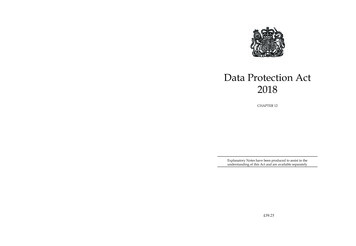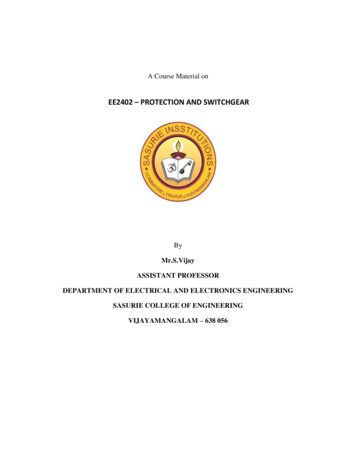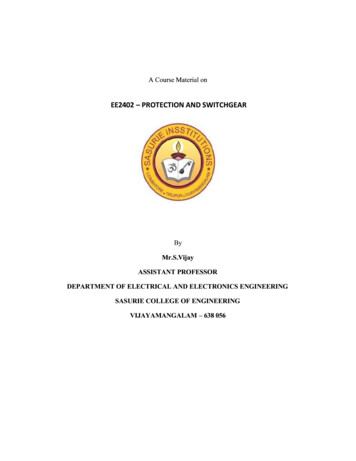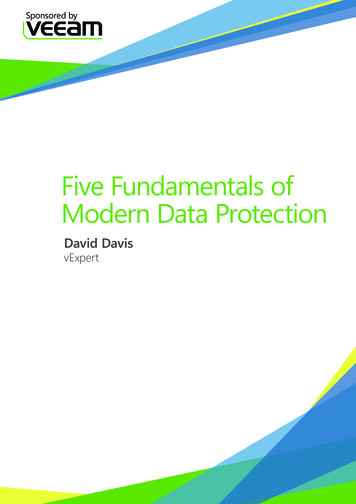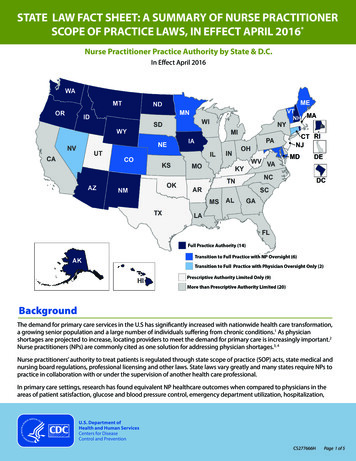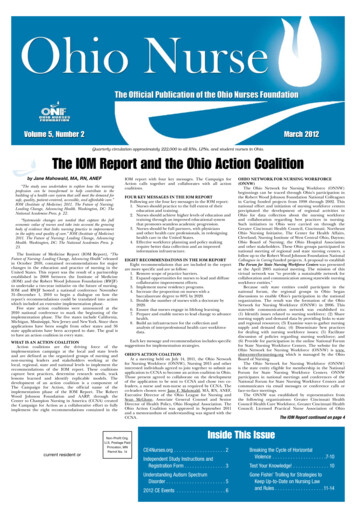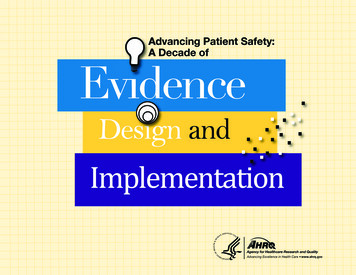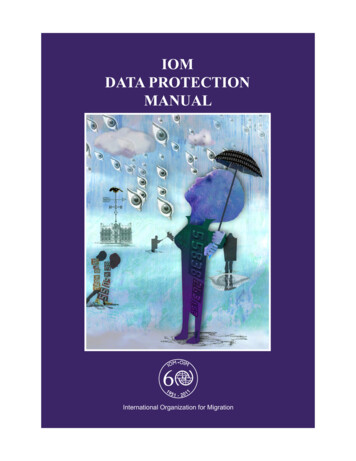
Transcription
,20 LV FRPPLWWHG WR WKH SULQFLSOH WKDW KXPDQH DQG RUGHUO\ PLJUDWLRQ EHQH¿WV PLJUDQWV DQG VRFLHW\ V DQ LQWHUJRYHUQPHQWDO RUJDQL]DWLRQ ,20 DFWV ZLWK LWV SDUWQHUV LQ WKH LQWHUQDWLRQDO FRPPXQLW\ WR DVVLVW LQ PHHWLQJ WKH RSHUDWLRQDO FKDOOHQJHV RI PLJUDWLRQ DGYDQFH XQGHUVWDQGLQJ RI PLJUDWLRQ LVVXHV HQFRXUDJH VRFLDO DQG HFRQRPLF GHYHORSPHQW WKURXJK PLJUDWLRQ DQG XSKROG WKH KXPDQ GLJQLW\ DQG ZHOO EHLQJ RI PLJUDQWV BBBBBBBBBBBBBBB3XEOLVKHUV ,QWHUQDWLRQDO 2UJDQL]DWLRQ IRU 0LJUDWLRQ URXWH GHV 0RULOORQV *HQHYD 6ZLW]HUODQG 7HO )D[ ( PDLO KT#LRP LQW ,QWHUQHW KWWS ZZZ LRP LQWBBBBBBBBBBBBBBB ,QWHUQDWLRQDO 2UJDQL]DWLRQ IRU 0LJUDWLRQ ,20&RYHU LOOXVWUDWLRQ YRQQH /HH ZZZ DOOHJRULF FR XNBBBBBBBBBBBBBBB OO ULJKWV UHVHUYHG 1R SDUW RI WKLV SXEOLFDWLRQ PD\ EH UHSURGXFHG VWRUHG LQ D UHWULHYDO V\VWHP RU WUDQVPLWWHG LQ DQ\ IRUP RU E\ DQ\ PHDQV HOHFWURQLF PHFKDQLFDO SKRWRFRS\LQJ UHFRUGLQJ RU RWKHUZLVH ZLWKRXW WKH SULRU ZULWWHQ SHUPLVVLRQ RI WKH SXEOLVKHU B
IOM DATA PROTECTION MANUAL
FOREWORDData protection is an area of law that is constantly evolving. This is due to privacy concernsassociated with the rapid growth of information technology and the fact that data are digitallytransferable and easily accessible. The increased incidences of data theft, data loss, andunauthorized or inappropriate use and disclosure of personal data have resulted in questionsrelating to the effective implementation of laws and policies. In addition, the use of advancedtechnology in migration management and document fraud presents diverse challenges linked todata protection and human rights. These concerns are compounded in situations whereinadvertent disclosure could result in harm or threat to the safety of individuals. Regardless ofregular or irregular movements, when individuals reveal their personal data for a particularpurpose, it should be handled with due care to protect their best interests and to ensure that theyare fully aware of any implication on their human rights.The international standards for collecting and processing personal data are acknowledgedworldwide. However, the lack of a binding international instrument has been the subject of muchdebate. At the 31st International Conference of Data Protection and Privacy Commissioners, aresolution was adopted by a number of States calling for a universal convention and recognizingthat data protection and privacy are fundamental rights attributed to all individuals, irrespective ofnationality or residence. It is IOM’s hope that content of this publication will add to thediscussion of stakeholders, both nationally and internationally.Notwithstanding the vast literature on this issue, there is limited guidance on protecting personaldata in the context of migration. IOM is pleased to make an early contribution to the ongoingdiscussions on data protection and we encourage further engagement on this important issue. Byway of background, IOM conducted a survey of selected registration projects in 26 field offices in2007. The survey illustrated that there was indeed a need to standardize the handling of personaldata throughout the Organization. IOM’s policy on data protection is informed by relevantinternational standards, in particular the core data protection principles as recognized by manyStates, and through research on policies and procedures in other organizations. The IOM dataprotection principles are designed to assist IOM staff to take reasonable and necessaryprecautions in order to preserve the confidentiality of personal data and to ensure that the rightsand interests of IOM beneficiaries are adequately protected. IOM’s policy on data protection hasbeen in force since May 2009 and lessons are learned on a daily basis. Although the content ofthis publication was developed for IOM use, it can be used as a resource tool by otherorganizations operating in similar contexts.As a final point, acknowledgement is due to the author, Ruzayda Martens, for developing IOM’sstrategy on this issue and for advancing data protection as a necessary consideration in IOM’swork.Richard PerruchoudData Protection3
ACKNOWLEDGEMENTSThe author would like to thank current and former IOM colleagues who pioneered theTechnology Application and Migration Management (TAMM) Data Protection Project, a jointeffort between the Department of Migration Management, the Department of InformationTechnology and Communications, and the International Migration Law and Legal AffairsDepartment. The Project benefited from the experience and expertise of a wide range of IOMcolleagues, both in the Field and at Headquarters. Sincere thanks and appreciation are due to theProject Team, Steering Committee and Working Group members who took time out of their busyschedules to contribute at various stages of the project.Firstly, particular thanks to the Project Team members: Shpëtim Spahiya for his contribution andsupport in the timely completion of the project and to Chiara Frattini, Jacqueline Straccia and ElifCelik for their research assistance.Secondly, much appreciation to the Steering Committee members: Yorio Tanimura, JillyanneRedpath-Cross and Bernardo Mariano for their expert guidance and indispensible contributions.Thirdly, special thanks to the Working Group members for their commitment and detailedfeedback: Nicholas Theotocatos, Norbert Wühler, Monica Halil, Walter Brill, Sarah Craggs,Delbert Field, Lea Matherson, Jobste Koheler, Christopher Gascon, Elizabeth Dunlap, DyaneEpstein, Goran Grujovic, Chintana Meegamarachchi, Mariko Tomiyama, Teresa Zakaria andJesus Sarol. Valuable comments were also received from various missions and individualcolleagues; thanks are due to, amongst others: Jonathan Martens, Miwa Takahashi, Ashraf ElNour, Richard Scott, Mio Sato, Amy Mahoney, Daniel Redondo, Ricardo Cordero, TanjaBrombacher, Mark Brown, Nasim Faruk, William Barriga, Gloria Ko, Patrick Corcoran, AbyeMakonnen, Ramiro Nochez-McNutt, Anna Eva Randicetti, and Robert Villamor.Finally, I wish to express my gratitude to Richard Perruchoud for his continuous support and tomy colleagues at the Office of Legal Affairs for their efforts to promote data protection in theirdaily work.Ruzayda Martens 151Legal Officer, IOM Geneva. It should be noted that the Data Protection Guidelines were developed to assist in the application of the13 IOM data protection principles. The views, findings, interpretations and conclusions expressed in the Data Protection Guidelinesare those of the author and the responsibility for any error remains that of the author.Data Protection
TABLE OF CONTENTSPART IPART IIPART IIIPAGE9IntroductionIOM Data Protection Principles1113Data Protection Guidelines13How to use the guidelines13Terminology13Data protection14Data subjectsPersonal data14Data processing1516Risk–benefit assessment18Data controllersGuiding points on IOM principles19Principle 1: Lawful and fair collection25Principle 2: Specified and legitimate purposePrinciple 3: Data quality3339Principle 4: Consent49Principle 5: Transfer to third parties57Principle 6: Confidentiality63Principle 7: Access and transparency69Principle 8: Data security79Principle 9: Retention of personal data85Principle 10: Application of the principles91Principle 11: Ownership of personal dataPrinciple 12: Oversight, compliance and internal remedies95Principle 13: Exceptions101Consideration boxes1. Ethical considerations15. Indicators for written transfer contract2. List of personal data16. Confidentiality indicators3. Sensitivity assessment17. Complaint considerations4. Risk action indicators18. Access considerations5. Effective risk–benefit assessment19. “Culture of data security” indicators6. Legal considerations20. Consideration for electronic records7. Fairness considerations21. Retention period8. Compatibility considerations22. Further retention considerations9. Research considerations23. Destruction considerations10. Reasonable steps to ensure accuracy24. Depersonalizing personal data11. Assessing continued relevance25. Ownership considerations12. Consent considerations26. Compliance and oversight considerations13. Respecting vulnerability27. Derogation considerations14. Foreseeable third parties105Annexure A: List of international instruments107Annexure B: List of national legislation109Glossary115Bibliography127IOM Generic Templates and ChecklistsData Protection7
INTRODUCTIONThe collection and processing of personal data are necessary components of IOM’s commitmentto facilitate migration movements, understand migration challenges, and respect the humandignity and well-being of migrants. IOM’s data protection strategy seeks to protect the interestsof IOM beneficiaries, as well as the Organization itself.Data protection is paramount for the safe exchange, secure storage and confidential treatment ofpersonal data. To enhance IOM operations and systems, data protection should be appliedsystematically throughout the Organization.IOM data protection statement“IOM shall take all reasonable and necessary precautions to preserve theconfidentiality of personal data and the anonymity of data subjects. Allpersonal data shall be collected, used, transferred and stored securely inaccordance with the IOM data protection principles.”Key objectives:999999To respect privacy and meet the expectations of data subjects.To protect the integrity and confidentiality of personal data.To prevent unnecessary and inappropriate disclosure of personal data.To provide comprehensive institutional safeguards for the handling of personal data.To enhance understanding of core concepts and international data protection standards.To give operational guidance for the implementation of the IOM data principles andguidelines.This publication provides practical guidance for protecting personal data in the context of migrantassistance. It consists of three parts: Part I outlines the 13 IOM data protection principles; Part IIprovides comprehensive data protection guidelines structured according to the 13 principles; andPart III consists of IOM operational templates and checklists.¾ This publication is designed to be a living document. It is capable of adaption andrevision to address emerging operational needs, policy developments and IOM systemsupgrade or improvement.¾ The application of the data protection measures outlined in this document may require aflexible approach, depending on the prevailing circumstances relating to projectimplementation.9The Office of Legal Affairs (LEG) at IOM Headquarters is the focal point on data protectionissues and can assist with training to raise awareness among IOM staff and stakeholders.Data Protection
PART I: IOM Data Protection PrinciplesIOM International Organization for MigrationPersonal dataIOM beneficiaries1.LAWFUL AND FAIR COLLECTIONPersonal data must be obtained by lawful and fair means with the knowledge or consent of thedata subject.2.SPECIFIED AND LEGITIMATE PURPOSEThe purpose(s) for which personal data are collected and processed should be specified andlegitimate, and should be known to the data subject at the time of collection. Personal data shouldonly be used for the specified purpose(s), unless the data subject consents to further use or if suchuse is compatible with the original specified purpose(s).3.DATA QUALITYPersonal data sought and obtained should be adequate, relevant and not excessive in relation tothe specified purpose(s) of data collection and data processing. Data controllers should take allreasonable steps to ensure that personal data are accurate and up to date.4.CONSENTConsent must be obtained at the time of collection or as soon as it is reasonably practicalthereafter, and the condition and legal capacity of certain vulnerable groups and individualsshould always be taken into account. If exceptional circumstances hinder the achievement ofconsent, the data controller should, at a minimum, ensure that the data subject has sufficientknowledge to understand and appreciate the specified purpose(s) for which personal data arecollected and processed.5.TRANSFER TO THIRD PARTIESPersonal data should only be transferred to third parties with the explicit consent of the datasubject, for a specified purpose, and under the guarantee of adequate safeguards to protect theconfidentiality of personal data and to ensure that the rights and interests of the data subject arerespected. These three conditions of transfer should be guaranteed in writing.6.CONFIDENTIALITYConfidentiality of personal data must be respected and applied at all stages of data collection anddata processing, and should be guaranteed in writing. All IOM staff and individuals representingthird parties, who are authorized to access and process personal data, are bound byconfidentiality.Data Protection11
7.ACCESS AND TRANSPARENCYData subjects should be given an opportunity to verify their personal data, and should be providedwith access insofar as it does not frustrate the specified purpose(s) for which personal data arecollected and processed. Data controllers should ensure a general policy of openness towards thedata subject about developments, practices and policies with respect to personal data.8.DATA SECURITYPersonal data must be kept secure, both technically and organizationally, and should be protectedby reasonable and appropriate measures against unauthorized modification, tampering, unlawfuldestruction, accidental loss, improper disclosure or undue transfer. The safeguard measuresoutlined in relevant IOM policies and guidelines shall apply to the collection and processing ofpersonal data.9.RETENTION OF PERSONAL DATAPersonal data should be kept for as long as is necessary, and should be destroyed or renderedanonymous as soon as the specified purpose(s) of data collection and data processing have beenfulfilled. It may however, be retained for an additional specified period, if required, for thebenefit of the data subject.10.APPLICATION OF THE PRINCIPLESThese principles shall apply to both electronic and paper records of personal data, and may besupplemented by additional measures of protection, depending, inter alia, on the sensitivity ofpersonal data. These principles shall not apply to non-personal data.11.OWNERSHIP OF PERSONAL DATAIOM shall assume ownership of personal data collected directly from data subjects or collected onbehalf of IOM, unless otherwise agreed, in writing, with a third party.12.OVERSIGHT, COMPLIANCE AND INTERNAL REMEDIESAn independent body should be appointed to oversee the implementation of these principles andto investigate any complaints, and designated data protection focal points should assist withmonitoring and training. Measures will be taken to remedy unlawful data collection and dataprocessing, as well as breach of the rights and interests of the data subject.13.EXCEPTIONSAny intent to derogate from these principles should first be referred to the IOM Office of LegalAffairs for approval, as well as the relevant unit/department at IOM Headquarters.12Data Protection
PART II: Data Protection GuidelinesThe purpose of these guidelines is to govern the implementation of the IOM data protectionprinciples (“IOM principles”) in a manner that recognizes both the right of individuals to protecttheir personal data and the need of IOM to collect, use and disclose personal data in the course offulfilling its migration mandate.Due to the multifaceted nature of IOM activities, data protection issues need to be considered atall stages, from project development and implementation to evaluation and reporting.1.How to use the guidelinesThe Data Protection Guidelines should be used in conjunction with other relevant IOM policiesand guidelines and should be read as a “how to” tool for incorporating data protection into currentpractices of collection, storage, use, disclosure and disposal of personal data.Consideration boxes are included andoperational templates and checklists areavailable as practical tools to assist datacontrollers in identifying the key factors to betaken into account at the various stages of dataprocessing.2.Box 1: Ethical considerations9 Respect the privacy and dignity of data subjects.9 Ensure safety and non-discrimination.9 Protect confidentiality of personal data.9 Prevent unauthorized disclosure andinappropriate use of personal data.TerminologyWhat is data protection?Data protection is the systematic application of a set of institutional,technical and physical safeguards that preserve the right to privacy withrespect to the collection, storage, use and disclosure of personal data. 2All individuals have a right to privacy. 3 The right to privacy is a universal right that is notrestricted to nationals of a country, nor is there a distinction between non-nationals in a regular oran irregular situation. In its commitment to respect the human dignity and well-being of migrantsand other beneficiaries, IOM seeks to ensure that personal data are handled with the utmost careand confidentiality. Improper use and unauthorized disclosure of personal data could result in amultitude of risks, ranging from physical violence to discrimination and social marginalization. Astandardized approach to data protection throughout IOM will assist with effective managementstrategies to protect IOM beneficiaries, as well as the Organization itself. The IOM principlesprovide a framework for data protection and govern the handling of all types of personal datarelating to IOM beneficiaries.2The definition of data protection has been adapted for IOM purposes and draws a distinction between data protection and datasecurity (see Glossary).3The IOM principles are based on relevant international instruments and standards. See Annexure A, which outlines the internationaland regional instruments governing the right to privacy and data protection, as well as Annexure B, which outlines national dataprotection legislation.Data Protection13
Box 2 : List of personal data9What about personal datarelating to IOM staff?Although the focus of the IOMprinciples are IOMbeneficiaries; these principles create abenchmark for data protection throughoutthe Organization.9Who are data subjects?9Data subjects are individuals who can bedirectly or indirectly identified by referenceto a specific factor or factors. Such factorsmay include a name, an identificationnumber, material circumstances, andphysical, mental, cultural, economic orsocial characteristics.All identified or identifiable beneficiaries who fallwithin the scope of IOM activities are considered to bedata subjects.99What is personal data?Personal data include all information thatcould be used to identify or harm datasubjects.When handling personal data, data controllers shouldalways consider sophisticated methods that could beused to identify data subjects.Whataresophisticatedmethods?Sophisticated methods refer toextraordinarymeansofgaining unauthorized access to personaldata, and require disproportionate time,effort, resource and determination.14999Biographical data such as name, date ofbirth, marital status, address or last placeof residence, employment, contact details,age, language, sex, gender, sexualorientation, race, ethnic or social origin,nationality, religion, culture, politicalopinions or other beliefs, membership of aparticular group, physical or mentaldisability and health status;Biometric and genetic data such asfingerprints, iris scans, hand patterns,facial image, voice recognition, and DNAsamples;Background data such as family andhousehold history, relationships withrelatives, community members, and closeassociates;Material circumstances such asexperience of human rights violations andtransit details including route taken,education, employment history, workaddress, as well as names and contactdetails of IOM staff or individualsrepresenting authorized third parties thatconduct interviews and collect personaldata;Images and recordings such as picturesor photographs, television images, videos,voice and digital recordings, medical Xrays, ultrasound and other medical images;Corroborating materials such as medicalreports, phsychological reports, hotlinereports, police or other official andunofficial reports;Personal documents such as healthrecords, financial records, bank details,and criminal records or activities;Verification documents such as originalsor copies of passports, identity cards,social security cards, birth certificates,temporary permits, driver’s licence, visas,marriage certificates, school diplomas,university records, medical certificates,property titles, and employment contractsor recruitment offers.Note: This list is not exhaustive; it merelyillustrates the types of personal data collectedand processed in the context of IOM activities.Sophisticated methods will vary depending on thesensitivity of the personal data and the nature of theIOM activity. Personal data that could be used tothreaten the life of data subjects and IOM staff orindividuals representing authorized third partiesshould be treated as highly sensitive.EXAMPLE:Links to organized crime may allowfor highly organized tracking methodsthat could be used to identify andlocate trafficked persons.Data Protection
Data controllers should conduct a sensitivity assessment prior to data collection, in order toidentify necessary safeguards, access controls and security measures to be applied throughout thelife cycle of data processing.The degree of sensitivity applied to personal datadepends on the nature of the IOM project, type of IOMactivity and the circumstances surrounding datacollection and data processing. This includes, interalia: the country situation; the target population group or individual datasubject; social and cultural attitudes; potential physical harm; and discrimination that could result from disclosure.Box 3: Sensitivity assessment¾ High sensitivity;¾ Moderate sensitivity;¾ Low sensitivity.Key considerationsPotential to harm the data subject;Potential to discriminate;Potential to harm other data subjects;Potential to harm IOM staff andindividuals representing authorized thirdparties.It is important to highlight the level of sensitivity applied to electronic andpaper records.What is data processing?Data processing is an overarching term that is used to describe all activitiesassociated with the handling of personal data.The IOM principles apply equally to all phases of data processing.Diagram outlining the different phases of data FERREPORTINGDESTRUCTIONNote: Data processing is not necessarily a continuum from data collection to destruction, but often a range of activitiesthat occur in parallel at various stages.Data Protection
Data controllers should ensure that donors, IOM partners, implementing partners and other thirdparties are aware of IOM’s commitment to safeguard personal data. This will foster cooperationand support the implementation of the IOM principles. Data controllers should incorporate theIOM principles into project proposals to cater for funding needs associated with, inter alia: data security measures;hardware and/or software devices;staff capacity; andtraining sessions.The importance of training cannot be overemphasized. Training should focus on IOM staff andauthorized third parties, as well as donors, IOM partners and implementing partners and otherrelevant stakeholders (see also principle 12).What is a risk–benefit assessment?Risk–benefit assessment is the process of evaluating the risks and benefitsassociated with data processing.A risk–benefit assessment 4 should be conducted prior to data collection and should apply to thesubstance, as well as the method of data collection and the means by which personal data will becaptured, stored and subsequently used.Data controllers should always weigh the probability of harm against theanticipated benefits, and ensure that the benefits significantly outweigh thepotential risks.Risks are dependent on the likelihood of it occurring and the severity of the harmful outcome.Even when unavoidable, risks can be reduced or managed. Precautions, safeguards, and feasiblealternatives should be incorporated into project development strategies, as well as the datacollection process, to reduce the possibility of harm or limit its severity or duration.16What happens if the risksoutweigh the benefits?Appropriate risk controlmeasuresshouldbeimplemented to prevent ormitigate the likelihood of the riskoccurring. If the risk is too high, datacontrollers should discontinue the dataprocessing.Box 4 : Risk action indicators¾ High risk: Unacceptable;¾ Moderate risk: Careful attention;¾ Low risk: Proceed with activity.High riskImmediately abandon the activityuntil measures to reduce the risk are implemented.Moderate riskApply careful attention andcontinuous monitoring, and, if necessary, stop theactivity to implement measures to reduce the risk.Low riskProceed with the activity andcontinuously monitor the risk–benefit ratio.4The risk–benefit assessment is not a technical evaluation that is valid under all circumstances. Rather, it is a value judgement thatoften depends on various factors, including, inter alia, the prevailing social, cultural and religious attitudes of the target populationgroup or individual data subject.Data Protection
It is important to continually assessthe risks and benefits throughout thelife cycle of data processing becausethe risk–benefit ratio may changeover time.Risk control measures may include:999999Box 5 : Effective risk–benefit assessment99Elimination: removing the risk is the safest and bestway to reduce the risk.Substitution: substituting the hazard with somethingless risky is the best alternative if elimination isimpossible.Containment: using strict supervisory controls canhelp minimize the likelihood of harm occurring.Reducing exposure: taking extra precautions canreduce the likelihood of harm occurring.Training: raising awareness at collection sites canassist with identifying and managing risks.Monitoring: continuous monitoring can helpidentify appropriate safeguards to minimize the risk.99What happens if the risk–benefit ratio changes afterdata collection?Data controllers should assessthe new risks in relation to the benefits andexplore feasible alternatives. If noalternative exists, all measures should betaken to minimize the risks and its adverseeffects. If the high risk continues, the dataprocessing should discontinue.9Data controllers should continue to weigh the risks andbenefits throughout the life cycle of data processing.999Identifying whether limitations to privacyand confidentiality are acceptable in lightof the reasonable expectations of datasubjects. This requires communicationwith data subjects to determine theirreasonable expectations.Determining whether the IOM project is ofsufficient importance to justify limitationsto the rights and interests of data subjects.The importance of the IOM project shouldbe based on IOM’s mandate and theprevailing circumstances surrounding theparticular IOM project, e.g. protection ofdata subjects, action required by theinternational community, public interest,human rights abuses, natural disasters, etc.Determining whether the safety, health anddiscriminatory risks are reasonable inrelation to the benefits and to what extentthe risks can be minimized.Considering the special circumstances andvulnerabilities of data subjects andpromoting sensitivity to gender, age,language, and the social, cultural orreligious attitudes of the target populationgroup or individual data subject.Ensuring that appropriate safeguards areincluded in the data collection process toprotect the rights and well-being of datasubjects who are likely to be vulnerable tocoercion or undue influence such as, interalia, minors, detained data subjects,pregnant women, the physically ormentally disabled, and data subjects whomay be economically or educationallydisadvantaged.Reviewing the balance between the risksand benefits at periodic intervals toaccount for the possibility of a shift in therisk–benefit ratio.Foreseeing adequate training of IOM staffand others involved in the data collectionprocess and ensuring that they are familiarwith risk control measures to reduce theprobability of harm occurring.Analysing how the flow of personal datawill impact on the rights and interests ofdata subjects throughout the life cycle ofdata processing.Note: When implementing data security, thedata controller should take appropriate action toensure that security measures minimize risksand maximize benefits.Data Protection17
Illustration of risk assessment at different phases of data processingData collection:Data controllers should weigh safety and security risks to determine the nature and extent ofpersonal data to be collected from conflict-affected populations when, for example, assigningshelter, providing food and engaging in camp organization. After conducting a fair assessment,appropriate action should be implemented to reduce the likelihood of any risks occurring and toensure that the benefits continue to outweigh the risks. IOM staff members should be briefedabout necessary precautions that would reduce the likelihood of harm, and the collection processshould be continuously monitored.Data retention:After registration, the benefits of storing personal data at camp sites and the risks associated withunauthorized disclosure should be taken into account to ensure that the personal data are storedin a safe location. Access to the storage site should be limited to authorized persons andappropriate data security measures should be implemented to prevent theft or unauthorizeddisclosure.Who is the data controller?Data controllers are individuals who are authorized to determine themann
18. Access considerations 19. "Culture of data security" indicators 20. Consideration for electronic records 21. Retention period 22. Further retention considerations 23. Destruction considerations 24. Depersonalizing personal data 25. Ownership considerations 26. Compliance and oversight considerations 27. Derogation considerations

